 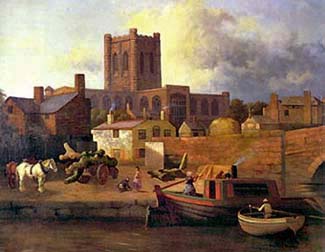 ollowing
the
rule
of St. Benedict, the
monks
of
Chester
Abbey
lived lives of simplicity, held all things in common, worshipped
eight
times
a
day,
studied,
cared
for
the
sick,
welcomed
travellers
and
distrubed alms to
the
poor. ollowing
the
rule
of St. Benedict, the
monks
of
Chester
Abbey
lived lives of simplicity, held all things in common, worshipped
eight
times
a
day,
studied,
cared
for
the
sick,
welcomed
travellers
and
distrubed alms to
the
poor.
Around the year 1195, one of their number, Lucian, wrote enthusiastically of his brothers:
"The visitor meets with a cheery
and kindly welcome and with joyful and affectionate looks. Food is put before
him and a place at table is freely granted him with befitting graciousness.
In their (the monks) characters are found simplicity, sincerity and refinement;
in their manners orderliness, calm and self-control. Their goodness, as if emanating
from the atmosphere of the place, should refresh every human mind.
Just as we
praise well-trained men because they are not borne down by the weight of their
arms or the pertinacity of the enemy, so we admire the monks of Chester because
they are not wearied by the toil of their joyful yoke.
To the local people they
are are cheery; to those who come from afar they are jovial, ready to open their
hearts to them. The seats about their table are worn by reason of their being
well-known and frequented by strangers.
Seldom are they free from crowds flocking
round them, and in all this do they follow the example of their King - if much
has been given you, distribute it liberally; if little, this also impart cheerfully."
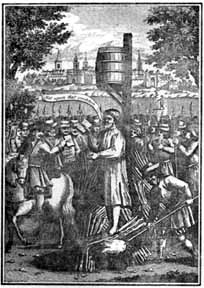 Bear in mind the importance with which the activities of these
monks were held by the entire society. They were considered of equal status to, for example, the military: the role of the soldier was to defend the country, perhaps giving his life in the process, while the monk devoted his life to prayer- it was believed by all to be vitally necessary to keep the 'spiritual batteries' topped up in order to defend the world from the clutches of the Evil One. Bear in mind the importance with which the activities of these
monks were held by the entire society. They were considered of equal status to, for example, the military: the role of the soldier was to defend the country, perhaps giving his life in the process, while the monk devoted his life to prayer- it was believed by all to be vitally necessary to keep the 'spiritual batteries' topped up in order to defend the world from the clutches of the Evil One.
During
the
later
middle
ages,
however,
the
Abbey
became
extremely
rich
and
powerful,
owning
land
and
property
throughout
Cheshire
and
far
beyond.
The Earls
of
Chester gave
the
Abbots
rights
equal
within
their
jurisdiction
to
their
own,
which
were
themselves
equal
to
those
of
the
Crown
elsewhere
in
the
country.
They
were
strict
landlords
and
hard
taskmasters.
The
medieval
trials
by
fire,
water
and
combat
were
practiced
in
the
Abbot's
courts
and
malefactors
were
summarily executed
by
the
Abbot's
officers.
After
the
Dissolution,
ecclesiastical
justice
continued
to
be
administered
in
the
Lady
Chapel.
It
was
here,
in
1555,
that George
Marsh,
a
widower
with
children,
was
condemned
to
death
for
preaching
the
'heretical'
doctrine
of Martin
Luther by the Bishop of Chester, George Coats.
George Marsh was the only person martyred in Cheshire under Queen Mary. He was a preacher from Deane, a suburb of Bolton. He first went about the neighbouring villages preaching stories from the bible but was later employed by King Edward VI in 1547 as a preaching minister. He was a tall man and an eloquent speaker. But during the reign of Queen Mary his preaching came into conflict with the new Catholic ways. He was brought before Justice Barton at Smithills Hall near Bolton (A sign there draws the visitor's attention to a mark in the floor, said to be a footprint made by Marsh when he stamped his foot during his interrogation). He refused to deny his beliefs and so was imprisoned for a time at Lancaster Castle where people flocked to his prison cell to hear him preach.
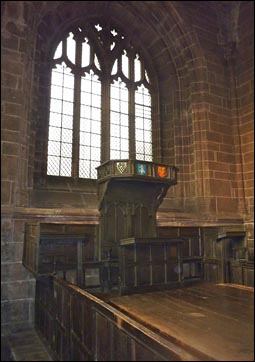 He was then moved to Chester to be tried and imprisoned in the terrible Northgate Gaol. He was given the chance to go free if he recanted but his refusal sealed his fate. He dragged on a hurdle to Spital Boughton (Chester's traditional place of execution, overlooking the River Dee about a mile from the town) where he was tied to the stake and a barrel of tar was set above his head to drip on him as he burned. It is said that the fire was badly managed and his death was "protracted". After it was over, his ashes were collected by his friends and buried in St Giles' Cemetery nearby. The spot where he, and countless others, died so cruelly is today marked by a memorial obelisk erected in the 19th century. He was then moved to Chester to be tried and imprisoned in the terrible Northgate Gaol. He was given the chance to go free if he recanted but his refusal sealed his fate. He dragged on a hurdle to Spital Boughton (Chester's traditional place of execution, overlooking the River Dee about a mile from the town) where he was tied to the stake and a barrel of tar was set above his head to drip on him as he burned. It is said that the fire was badly managed and his death was "protracted". After it was over, his ashes were collected by his friends and buried in St Giles' Cemetery nearby. The spot where he, and countless others, died so cruelly is today marked by a memorial obelisk erected in the 19th century.
In
1636,
the
Bishop's,
or Consistory, Court
(illustrated right) was
moved
from the Lady Chapel into
the
unfinished
south-west
tower
of
the
Cathedral,
where
its
heavy oak
furnishings- an enclosure with a bench, surrounding a large table,
may still be inspected by visitors
today,
the
only
complete
example
to survive in
all
of
England. Consistory courts dealt with all manner of legal issues affecting the church, some of a life and death seriousness but many more trivial- disputes about alterations to church buildings and the like. The last case heard at Chester was in the 1930s and concerned a priest who had attempted suicide.
Although the spiritual activities of the Abbey continued, by
the
14th
century,
many
of
the
monks
were
living
a
life
of
relative
ease,
often
discarding
their
habits
for
fashionable
dress
with
ornamental
belts
and
trimmings.
They
hunted
in
the
forest
and
feasted
noisily-
their
scraps
going
not
to
the
poor
but
to
feed
greyhounds
and
hunting
dogs.
Around
1480,
it
was
recorded
that "divers
wymen"
were
accused
of
being
"the
paramours
of
the
monkes
of
Chester".
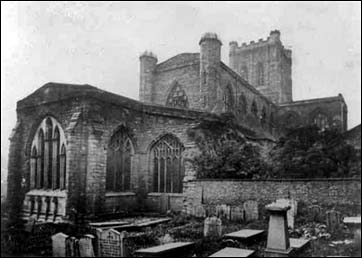 The
Abbot
was
all-powerful
within
his
domain,
answerable
only
to
the
Bishop
and
the
Pope.
By
the
16th
century,
the
monks
were
building
fine
new
halls
on
their
estates,
the
chief
of
these
being
at Saighton Grange,
about
four
miles
south-east
of
Chester,
where
they
laid
out
a
thousand-acre
park. The
Abbot
was
all-powerful
within
his
domain,
answerable
only
to
the
Bishop
and
the
Pope.
By
the
16th
century,
the
monks
were
building
fine
new
halls
on
their
estates,
the
chief
of
these
being
at Saighton Grange,
about
four
miles
south-east
of
Chester,
where
they
laid
out
a
thousand-acre
park.
A 19th century photograph of the Cathedral, taken just before the commencement of its radical restoration. No trace of the wall on the right or of the extensive graveyard remain with us today.
The Domesday Book
records
Saighton
as
belonging
to
'St. Werburgh's',
referring
to
the
Saxon
minster
run
by
canons-
the
Benedictine monks
came
six
years
later,
in
1092.
They
developed
the
land
as
a
grange,
or
agricultural
estate,
later
incorporating
a
country
retreat
for
the Abbots.
In
1249
they
'crennelated'- fortified-
the
buildings, the
Welsh
border
being
not
far
away,
and
in
the
1490s,
during
the
reign
of
Henry
VII,
Abbot
Simon
Ripley
rebuilt
the
gatehouse
and
marked
it
with
his
crest
of
a
black
dog
and
the
motto "Advance
Boldly".
The only surviving part of the monastic grange is the gatehouse, which has been designated by English Heritage as a Grade I listed building, and is one of only two surviving monastic manorial buildings in Cheshire, the other being Ince Manor. The
rest
of
the
buildings
are
Victorian
and
modern
and
are
now
the
home
of Abbey
Gate
College,
whose
motto
remains "Advance
Boldly".
But all
this
was
to
end
suddenly in
1540
with
the
Reformation
and
Henry
VIII's Dissolution
of
the
Monasteries.
In
the colourful
words of local guide and author Thomas
Hughes, "Bluff
King
Hal,
that
shameless
polygamist,
in
a
fit
of
pretended
religious
zeal,
dissolved
all
these
fraternities,
and,
pocketing
the
spoil,
dealt
out
their
lands
to
his
creatures
with
right
royal
munificence".
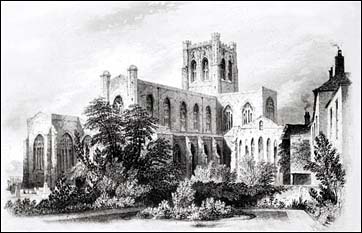
Throughout
the
country,
the
splendid
old buildings
were
dismantled
and
sold
off
for
building
materials
and
the
monks
cast
out,
but
in
Chester,
St. Werburgh's
Abbey
was
transformed
into
the 'Cathedral
Church of Christ and the Blessed Virgin Mary' and
thus
it
was
that John
Clarke,
the
25th
and
last
Abbot,
became
the
first
Dean.
He
did
not
long
enjoy
his
new
office,
which
began
4th
August
1541,
as
he
died
the
following
month.
We
can hardly
blame
Abbot Clarke
for
surrendering
his
monastery,
for
it
had
become
obvious
that
there
was
no
alternative-
his
predecessor,
Thomas
Marshall,
who
had
been
become
Abbot
of Colchester
Abbey,
refused
to
give
up
his
house,
and, in 1539,
was
hanged
outside
its
gates.
The
same
thing
happened
to
the
Abbots
of Reading and Glastonbury.
Of
the
twenty two
monks
resident
at
the
Abbey
in
1538,
ten
were
selected
to
remain
as
members
of
the
Cathedral
staff
and
the
rest
were
issued
with
pensions
and
lump-sum
gratuities
of
approximately
a
half-year's
pension,
in
order
to
pay
for
their
secular
clothing,
food
and
accomodation
until
their
first
pension
payments
became
due.
Thus,
they
can
hardly
be
said
to
have
been
harshly
treated.
"A Mouldering Sandstone Cliff"
At
first,
the
fabric
of
the
new cathedral
was
treated
with
almost
as
little
respect
as
that
of
the
other
dissolved
abbeys.
By
1580,
it
was said to be "in
great
decay
and
the
glasse
thereof
carryed
to
their
pryvate
benefices
by
the
Dean
and
Chapter".
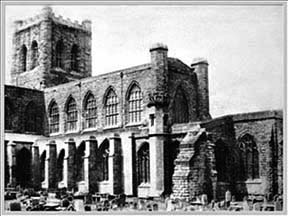 When
the
Roman Legions
built
the
fortress
of
Deva,
they
were
obliged
to
utilise
the
local
sandstone,
but
had
the
wisdom
to
use
only
the
hardest
types
available.
(Chester's
finest
extant
example
of
Roman
masonry,
the North
Wall,
in
places
stands
strong
and
proud
after
seventeen
centuries).
The
monks
of
the
rapidly-expanding
Abbey
seemingly
lacked
the
Roman
engineer's
knowledge
and
worked
largely
with
softer,
but
more
easily
obtainable,
types
of
stone.
Consequently,
over
the
centuries,
the
fabric
of
the
building
became
seriously
eroded.
The
Cathedral,
in
common
with
the
rest
of
the
town,
had
been
badly
treated
during
the
Siege
of
Chester
during the English Civil War in
the
1640s,
and
lead
was
stripped
from
the
roof
in
order
to
make
musket
balls. When
the
Roman Legions
built
the
fortress
of
Deva,
they
were
obliged
to
utilise
the
local
sandstone,
but
had
the
wisdom
to
use
only
the
hardest
types
available.
(Chester's
finest
extant
example
of
Roman
masonry,
the North
Wall,
in
places
stands
strong
and
proud
after
seventeen
centuries).
The
monks
of
the
rapidly-expanding
Abbey
seemingly
lacked
the
Roman
engineer's
knowledge
and
worked
largely
with
softer,
but
more
easily
obtainable,
types
of
stone.
Consequently,
over
the
centuries,
the
fabric
of
the
building
became
seriously
eroded.
The
Cathedral,
in
common
with
the
rest
of
the
town,
had
been
badly
treated
during
the
Siege
of
Chester
during the English Civil War in
the
1640s,
and
lead
was
stripped
from
the
roof
in
order
to
make
musket
balls.
In the early years of the 18th century, the famous author
of Robinson Crusoe, Moll Flanders and much else, Daniel
Defoe wrote of his visit to the Cathedral, "'tis
built
of
a
red,
sandy,
ill-looking
stone,
which
takes
much
from
the
beauty
of
it,
and
which
yielding
to
the
weather,
seems
to
crumble,
and
suffer
by
time,
which
much
defaces
the
building"
and
by
1798,
it
was
described
as "one
of
the
most
heavy,
irregular
and
ragged
piles".
Years later, the author Charles Hiatt recalled that "the surface rot of the very perishable red sandstone, of which the cathedral was built, was positively unsightly" and that the "whole place, before its restoration, struck one as woebegone and neglected; it perpetually seemed to hover on the verge of collapse, and yet was without a trace of the romance of the average ruin".
Not that
the
problems
of
decaying
stonework
and shoddy maintainance were confined
just to
the
Cathedral.
The
lovely
church
of St. John
the
Baptist over
the
centuries
suffered
no
less
than three collapses
of
its towers-
the
central
tower twice during
the
middle
ages
and
the
great
west
tower
as
recently
as
1881.
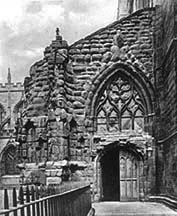 Writing
of
the
West
Front
of
the
Cathedral
in
1854, author and guide Thomas
Hughes said "Time
has,
of
course,
been
at
work
here,
as
elsewhere,
gnawing
away
at
the
old
red
sandstone;
but
there
is
still
enough
left
to
give
us
an
idea
of
its
ancient
beauty...
but it is
now
fast
going
to
decay." Writing
of
the
West
Front
of
the
Cathedral
in
1854, author and guide Thomas
Hughes said "Time
has,
of
course,
been
at
work
here,
as
elsewhere,
gnawing
away
at
the
old
red
sandstone;
but
there
is
still
enough
left
to
give
us
an
idea
of
its
ancient
beauty...
but it is
now
fast
going
to
decay."
(This remarkable aerial view- a detail from John McGahey's famous View of Chester from a Balloon- shows the cathedral and its surroundings as they appeared around this time).
Right: "The decay has gone deep into the stone and left its courses projecting, rounded and shapeless, like the layers of a mouldering rock"
Consequently,
a
number
of
more-or-less
necessary
restorations
have
taken
place. An early one- in 1702- was financed by King William III allowing the Dean & Chapter to organise a general collection throughout the parish churches of the entire country; fourteen shillings and sixpence was donated by the congregation of Llanymblodwell and four shillings and sixpence from Llanymynech, both in Montgomeryshire and the good folk of Ormesby St. Margaret in Norfolk contributed two shillings and twopence. As many as four restorations took place during
the
19th
century
alone-
by Thomas
Harrison in
1818-20, R. C. Hussey in
1843, Sir
George
Gilbert
Scott in
1868-76
and Sir
Arthur
Blomfield in
1882-87.
Thomas Harrison, the prolific Chester architect who was also responsible for the Grosvenor Bridge, the rebuilding of the Castle, the Northgate and much else, fell out seriously with the Dean and Chapter who, while
responsible for the maintainance of the Cathedral fabric, wanted to pay someone else less than he asked to supervise the plans he had so painstakingly prepared. In a forthright letter, he "presumed the Dean... wished to have a man of some experience to advise with, and superintend, the necessary works of this decayed building" and then asked rhetorically, "You cannot imagine that I, or any other person, would willingly lend his name as architect to the repairs required in this almost ruinous church... without having the superindendence of such repairs. Would the public be as ready to free me from the responsibility of any failure as the Chapter express themselves to be? I doubt it much".
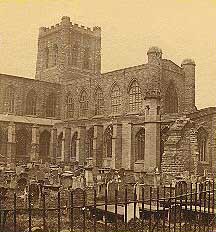
Harrison was famously abrupt, but he knew his business and his opinion was doubtless valid, since, amazingly, virtually no maintainance work had been carried out on the building since the 1530s- 300 years previously!
What the aforementioned Dean and his preceding 'guardians of the fabric' had been doing during all this time is anyone's guess. Nontheless, the work on rebuilding the buttresses of the south transept, whose stability had long been a cause for concern, and also of repairing its gutters, went ahead without him. The latter work was so badly executed that it had to be redone a mere six years later. To add insult to injury, Harrison was not even paid his princely fee of £25 for his work during his lifetime. He may have considered himself a professional man, worthy of reasonably prompt payment for services rendered, but in the eyes of that 'Man of God', the Dean of Chester, he was a mere tradesman, whose bills could be paid when it was deemed convenient- or not at all. The money only appeared ten years after Harrison's death, and then only then when his executors threatened to kick up a fuss about it.
Scott's
restoration was
by far the
most
radical-
before work commenced, he
wrote
that
virtually
the
entire
building "was
so
horribly
and
lamentably
decayed
as
to
reduce
it
to
a
mere
wreck,
like
a
mouldering sandstone
cliff". In a lecture in 1870 outlining his proposals, he declared that "probably no building in England has suffered so severely... the decay has gone deep into the stone and 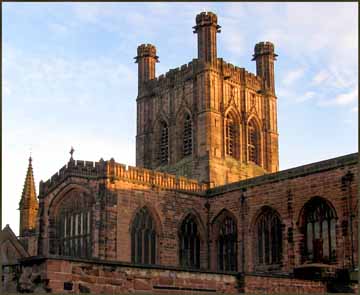 left its courses projecting, rounded and shapeless, like the layers of a mouldering rock. It is a distressing kind of work, yet, if conscientiously carried out it is the saving of the old design, even though the old material gives way to new." left its courses projecting, rounded and shapeless, like the layers of a mouldering rock. It is a distressing kind of work, yet, if conscientiously carried out it is the saving of the old design, even though the old material gives way to new."
The
situation
is clearly
illustrated
in
the
two
photographs
above-
both
of
which
had
been
taken
after
some
restoration
had
taken
place-
notice
how
radically
different
those
sections
appear.
Chester Cathedral bathed in winter sunlight: January 2007, photographed by the author.
Scott
was
amazed
to
discover
that
the
eastern
part
of
the
church
had no
foundations
at
all,
and
it
consequently
had
to
be
underpinned,
with
foundations
inserted
and
missing
buttresses
replaced. Work
on
the
Lady
Chapel
revealed,
at
a
depth
of
nine
feet
below
the
present
surface,
a
Roman
concrete
floor,
a
drain
and
traces
of
a
road,
which
ran
diagonally
under
the
south-eastern
buttress.
His aim in the restoration was to make the building conform to his Victorian concept of a mid-thirteenth century 'ideal' but he seems to have overdone it to a great degree, especially on the outside of the building- the numerous 'fancy' features such as the flying buttresses, the parapets along the lines of the roof, the many pinnacles, the gargoyles and the curious five-sided apse at the end of the South Choir Aisle are all his inventions, being entirely absent in the original. It was also his intention to erect a tall steeple on top of the central tower but lack of money meant that this was never achieved. The four over-large turrets atop the tower would doubtlessly have looked more in keeping had this been built.
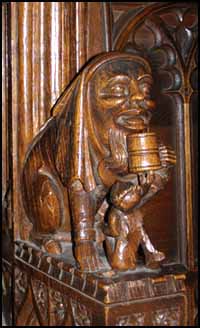
When the work was complete, one writer thought the Cathedral "a building which, if rather painfully new in appearance, is at least sound, strong and water-tight".
Another of the strange medieval carvings in the choir of Chester Cathedral- half beast, half pilgrim enjoying a mug of ale.
Sir George
(1811–78) was a leader in the Gothic Revival in England and may be better known the architect of some of London's best known landmarks, the Albert Memorial, St. Pancras Station (where his son, also named George, tragically committed suicide in 1897) and the Foreign & Commonwealth Office in Whitehall. His working life had commenced with less glamourous commissions, however, notably workhouses and prisons. During his long carreer, he found time to build or restore over 700 buildings around the country. Apart from Chester, Sir George also restored Ely Cathedral and Westminster Abbey- where he is buried.
Sir George's
grandson, Sir
Giles
Gilbert
Scott (1880–1960) also
undertook
an
extensive
programme
of
restoration
at
Chester
in
1911-13,
including
the
refectory
and
the
badly-decayed cloisters-
at
the
same
time
as
he
was
also
engaged
in
an
epic
undertaking
twenty
miles
away:
the
construction
of
the
swan
song
of
the
Gothic
in
England,
the
stupendious Liverpool
Anglican Cathedral. He now lies at the crossing beneath his gigantic tower.
Sir
Giles
was
also
the
architect of Battersea Power Station, restored the House of Commons Chamber after it was damaged in a bombing raid in 1941 and designed the famous British K2 red telephone box- compare its proportions with those of the great tower of Liverpool Cathedral- the similarities are unmistakable!
When
you
come
to
the
UK,
a
visit
to
Chester's
ancient
cathedral
followed
by
the
two
magnificent
modern
ones
in
Liverpool
is
an
unforgettable
experience. This writer would be pleased to be your guide...
Now
go
on
to part
III of
our
exploration
of
Chester
Cathedral...
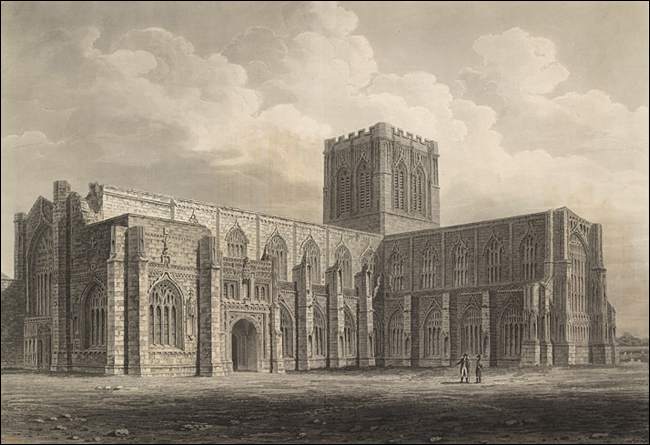
Chester Cathedral in 1811
Curiosities from Chester's
History no. 9
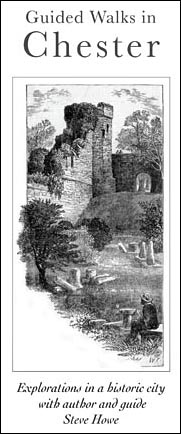 1399 Henry
Bolingbroke,
Duke
of
Lancaster
(later King Henry IV: 1367-1413) mustered
his
troops
under
the
walls
and
marched
against Richard
II,
whom
he
took
at Flint
Castle.
He
returned
to
Chester
with
the
unfortunate
monarch
(dressed
in
the
monk's
robe
in
which
he
attempted
to
escape)
and
the
Earl
of
Salisbury,
"mounted
on
two
little
white
nagges
not
worth
40
francs"
and
lodged
them
in
the Castle.
After
resting
in
a
tower
over
the
outer
gateway,
they
were
escorted
to
Westminster.
Piers
Legh,
a
supporter
of
Richard,
would
not
accompany
them,
as
he
was
executed
and
his
head
was
displayed
on
one
of
the
Castle's
towers.
Bolingbroke
deposed
Richard-
who
was
murdered
in
prison
the
following
year-
and
was
elected King
Henry
IV by
Parliament. 1399 Henry
Bolingbroke,
Duke
of
Lancaster
(later King Henry IV: 1367-1413) mustered
his
troops
under
the
walls
and
marched
against Richard
II,
whom
he
took
at Flint
Castle.
He
returned
to
Chester
with
the
unfortunate
monarch
(dressed
in
the
monk's
robe
in
which
he
attempted
to
escape)
and
the
Earl
of
Salisbury,
"mounted
on
two
little
white
nagges
not
worth
40
francs"
and
lodged
them
in
the Castle.
After
resting
in
a
tower
over
the
outer
gateway,
they
were
escorted
to
Westminster.
Piers
Legh,
a
supporter
of
Richard,
would
not
accompany
them,
as
he
was
executed
and
his
head
was
displayed
on
one
of
the
Castle's
towers.
Bolingbroke
deposed
Richard-
who
was
murdered
in
prison
the
following
year-
and
was
elected King
Henry
IV by
Parliament.
These
great
events
were,
of
course,
immortalised
by
Shakespeare
and John
Speed commented
of
Richard,
"If
to
spare
his
people's
bloud
he
was
contented
so
tamely
to
quit
his
royall
right,
this
fact
doth
not
only
seeme
excusable,
but
glorious;
but
men
rather
think
that
it
was
sloth,
and
a
vaine
trust
in
ddissimulation
which
his
enemies
had
long
since
discovered
in
him."
- 1400 The
Blue
Bell
Inn in
Lorimer's
Row, Northgate
Street dates
from
this
period.
The
Mayor
ordered
to
"apprehend
and
imprison
John
and
Adam
Hesketh
for
they
had
broken
into
the
Castle
and
stolen
the
keys
to
the Eastgate,
beheaded
Thomas
Molineux
and
proclaimed
against
the
King."
- 1403
The
citizens
of
Chester
were
pardoned-
upon
payment
of
300
marks-
for
encouraging
the
rebellion
of
the
Earl
of
Northumberland
and
his
son Lord
Percy (known
as
Hotspur)
against
King
Henry
IV.
They
had
proclaimed
on
two
occasions
that
Richard
II
was
alive,
and
imprisoned
in Chester
Castle. Henry, Prince of Wales, issues an order expelling the Welsh from Chester.
- 1413
Henry
IV
died,
his
son
ascended
as Henry
V (1386-1422).
Thomas
Erdeley
becomes
twentieth
Abbot
of
St.
Werburgh's
(-1434)
- 1422
Henry
V
died.
His
9
month-old
son
ascended
the
throne
as Henry
VI (1421-1471).
- 1431 Joan
of
Arc burned
at
the
stake
at
Rouen
- 1435
A
great
dearth
in
Chester:
the
people
made
bread
of
peas, feathers and
fern
roots.
This
strange
reference
to
eating
feathers
probably
occured
due
to
a
scribe's
misunderstanding
regarding vetches-
wild
peas-
as
vetches
was
also
the
name
given
to
the
flights
of
arrows
made
from
feathers!
John
de
Saughall
becomes
twenty
first
Abbot
of
St.
Werburgh's
(-1455)
- 1438
Inca
rule
established
in
Peru
- 1441
Rockley
and
Rooley,
gaolers
of
the
Castle
and Northgate,
fought
a
pitched
battle
to
settle
their
differences
on
the Roodee
- 1445
Henry
VI
visited
Chester
at
a
time
when
the
river
was
silted
up,
and
no
large
ship
could
approach
within
12
miles
of
the
city,
and
the
town
was
consequently
in
a
desolute
and
ruinous
condition
with
a
declining
population.
The
King
agreed
to
remit
half
of
the
£100
per
annum
fee
farm
rent
charged
under
the
charter
of
Edward
I.
|

 ollowing
the
rule
of St. Benedict, the
monks
of
Chester
Abbey
lived lives of simplicity, held all things in common, worshipped
eight
times
a
day,
studied,
cared
for
the
sick,
welcomed
travellers
and
distrubed alms to
the
poor.
ollowing
the
rule
of St. Benedict, the
monks
of
Chester
Abbey
lived lives of simplicity, held all things in common, worshipped
eight
times
a
day,
studied,
cared
for
the
sick,
welcomed
travellers
and
distrubed alms to
the
poor.  Bear in mind the importance with which the activities of these
monks were held by the entire society. They were considered of equal status to, for example, the military: the role of the soldier was to defend the country, perhaps giving his life in the process, while the monk devoted his life to prayer- it was believed by all to be vitally necessary to keep the 'spiritual batteries' topped up in order to defend the world from the clutches of the Evil One.
Bear in mind the importance with which the activities of these
monks were held by the entire society. They were considered of equal status to, for example, the military: the role of the soldier was to defend the country, perhaps giving his life in the process, while the monk devoted his life to prayer- it was believed by all to be vitally necessary to keep the 'spiritual batteries' topped up in order to defend the world from the clutches of the Evil One. He was then moved to Chester to be tried and imprisoned in the terrible Northgate Gaol. He was given the chance to go free if he recanted but his refusal sealed his fate. He dragged on a hurdle to Spital Boughton (Chester's traditional place of execution, overlooking the River Dee about a mile from the town) where he was tied to the stake and a barrel of tar was set above his head to drip on him as he burned. It is said that the fire was badly managed and his death was "protracted". After it was over, his ashes were collected by his friends and buried in St Giles' Cemetery nearby. The spot where he, and countless others, died so cruelly is today marked by a memorial obelisk erected in the 19th century.
He was then moved to Chester to be tried and imprisoned in the terrible Northgate Gaol. He was given the chance to go free if he recanted but his refusal sealed his fate. He dragged on a hurdle to Spital Boughton (Chester's traditional place of execution, overlooking the River Dee about a mile from the town) where he was tied to the stake and a barrel of tar was set above his head to drip on him as he burned. It is said that the fire was badly managed and his death was "protracted". After it was over, his ashes were collected by his friends and buried in St Giles' Cemetery nearby. The spot where he, and countless others, died so cruelly is today marked by a memorial obelisk erected in the 19th century.
 The
Abbot
was
all-powerful
within
his
domain,
answerable
only
to
the
Bishop
and
the
Pope.
By
the
16th
century,
the
monks
were
building
fine
new
halls
on
their
estates,
the
chief
of
these
being
at Saighton Grange,
about
four
miles
south-east
of
Chester,
where
they
laid
out
a
thousand-acre
park.
The
Abbot
was
all-powerful
within
his
domain,
answerable
only
to
the
Bishop
and
the
Pope.
By
the
16th
century,
the
monks
were
building
fine
new
halls
on
their
estates,
the
chief
of
these
being
at Saighton Grange,
about
four
miles
south-east
of
Chester,
where
they
laid
out
a
thousand-acre
park.




 left its courses projecting, rounded and shapeless, like the layers of a mouldering rock. It is a distressing kind of work, yet, if conscientiously carried out it is the saving of the old design, even though the old material gives way to new."
left its courses projecting, rounded and shapeless, like the layers of a mouldering rock. It is a distressing kind of work, yet, if conscientiously carried out it is the saving of the old design, even though the old material gives way to new." 
